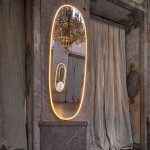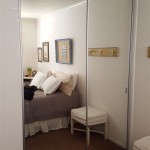Bathroom Mirror Mounting: A Comprehensive Guide
Installing a bathroom mirror is a common DIY project that can significantly enhance the aesthetic appeal and functionality of a bathroom. However, choosing the right mounting method and executing the process correctly is crucial for a secure and long-lasting installation. This guide provides a comprehensive overview of bathroom mirror mounting techniques, encompassing factors to consider, step-by-step instructions, and essential tips for achieving a professional finish.
Factors to Consider Before Mounting
Before embarking on the installation process, it is imperative to consider several factors that will influence the chosen mounting method and overall success of the project. These factors include:
- Mirror Size and Weight: The size and weight of the mirror will dictate the type of mounting hardware required. Heavy mirrors demand robust mounting solutions, such as heavy-duty adhesives or specialized brackets.
- Wall Material: The composition of the wall also plays a critical role. Drywall, plaster, concrete, and tile require different mounting strategies. For instance, drywall necessitates the use of anchors for secure attachment.
- Existing Wall Fixtures: The presence of electrical outlets, plumbing fixtures, or other wall features must be considered to avoid interference during installation and to ensure proper placement of the mirror.
- Desired Aesthetics: The style of the bathroom and the desired aesthetic of the mirror installation will guide the choice of mounting hardware and the visibility of the attachment points.
Popular Bathroom Mirror Mounting Methods
Several common methods are employed for bathroom mirror mounting, each offering distinct advantages and limitations. The most prevalent techniques include:
1. Adhesive Mounting
Adhesive mounting is a popular choice for lighter mirrors, particularly those with a smooth, flat back. It involves applying a strong adhesive to the back of the mirror and attaching it directly to the wall. This method offers a clean, unobtrusive appearance and can be suitable for various wall materials.
2. Bracket Mounting
Bracket mounting is often preferred for heavier mirrors and situations where a robust attachment is required. In this method, brackets are secured to the wall, and the mirror is then hung onto these brackets using specialized hangers or clips. Brackets provide excellent support and allow for adjustable height and alignment.
3. Hanging with Wire and D-Rings
This traditional method involves attaching D-rings to the back of the mirror and then hanging it using a wire that is secured to a hook on the wall. This technique is commonly used for framed mirrors and offers flexibility in adjustment and removal.
Step-by-Step Guide to Mounting a Bathroom Mirror
The following steps provide a general guideline for mounting a bathroom mirror, but specific instructions may vary depending on the chosen mounting method:
1. Prepare the Wall
Clean the wall thoroughly to remove dirt, debris, and any existing finishes that could hinder adhesion. If necessary, fill in any holes or cracks with spackle or patching compound and allow it to dry completely.
2. Mark the Mirror Placement
Use a level and pencil to mark the desired location for the mirror on the wall. Ensure the placement is aesthetically pleasing and avoids obstructions.
3. Install Mounting Hardware
Based on the chosen mounting method, install the appropriate hardware, such as brackets, adhesive strips, or hooks. For brackets, drill pilot holes and secure them into the wall using screws. For adhesives, apply the adhesive strips to the back of the mirror and allow them to cure according to the manufacturer's instructions.
4. Hang the Mirror
Carefully lift and hang the mirror onto the installed hardware, ensuring it is level and properly aligned with the marked position. If using brackets, use leveling tools to ensure the mirror is plumb before securing it.
5. Secure the Mirror
Once the mirror is in place, secure it firmly using screws or by pressing it firmly onto the adhesive strips until it adheres securely to the wall. Be careful not to overtighten screws if using brackets.
Additional Tips for a Professional Finish
To achieve a professional finish and ensure optimal longevity of the mirror installation, consider the following:
- Use High-Quality Hardware: Invest in high-quality mounting hardware that is specifically designed for mirrors and wall materials. This ensures a secure and enduring installation.
- Follow Manufacturer Instructions: Adhere to the manufacturer's instructions regarding the use and application of specific mounting products, such as adhesives or brackets. This will ensure proper installation and minimize the risk of failure.
- Level the Mirror Carefully: Use a level to ensure that the mirror is perfectly plumb. This detail enhances the aesthetics and functionality of the installation.
- Clean and Maintain: Regularly clean the mirror and its surrounding area to prevent dust, moisture, and grime from hindering its shine and compromising the longevity of the installation.

How To Pick And Hang The Perfect Bathroom Mirror Roomhints

How To Hang A Mirror On Window 12 Bright Beautiful Examples Designed

Tutorial How To Hang A Bathroom Mirror The Diy Playbook

Vanity Mirror Mounted On Pole Design Ideas

Suspended Mirror Bath

400mmx500mm Vanity Led Illuminated Bathroom Mirror Wall Mount Makeup Fruugo Nl

Home Dzine Bathrooms How To Mount A Bathroom Mirror

Rounded Rectangular Hanging Rod Mirror Hotel Bathroom Homestay Luminous China Frame Glass Modern Made In Com

How To Pick And Hang The Perfect Bathroom Mirror Roomhints

Forclover 24x 32 Inch Bathroom Vanity Mirror Wood Framed Horizontal Vertical Wall Mounted Hanging For Bedroom Living Room Entryway Decor White Com








